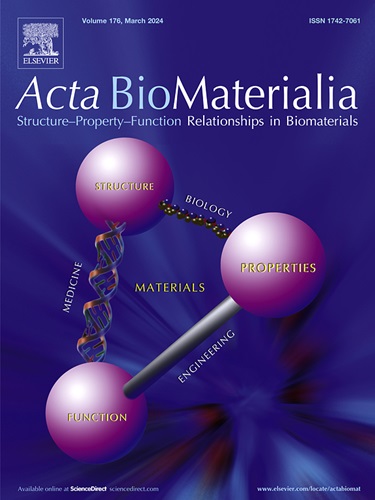Quantifying structural changes in organised biomineralized surfaces using synchrotron Polarisation-Induced Contrast X-ray Fluorescence
IF 9.4
1区 医学
Q1 ENGINEERING, BIOMEDICAL
引用次数: 0
Abstract
The quantitative characterization of the structure of biomineral surfaces is needed for guiding regenerative strategies. Current techniques are compromised by a requirement for extensive sample preparation, limited length-scales, or the inability to repeatedly measure the same surface over time and monitor structural changes. We aim to address these deficiencies by developing Calcium (Ca) K-edge Polarisation Induced Contrast X-ray Fluorescence (PIC-XRF) to quantify hydroxyapatite (HAp) crystallite structural arrangements in high and low textured surfaces. Minimally prepared human dental enamel was used as an exemplar to quantify initial surface structures, and the disruption caused by short dietary acid exposures. By measuring surfaces at different rotational angles relative to a polarised focused (2×2 µm) monochromatic X-ray source (at either 4049.2 and 4051.1 eV) it was possible to discriminate the principal and secondary orientations of surface crystallites, along with their texture. It was also possible to quantify the organisation of crystallites in both low (enamel cross-sections) and highly textured (facial enamel) surfaces including the identification of crystallites aligned perpendicular to the surface—a challenge for other synchrotron techniques. Surface modifications following short term acid erosion (affecting <20 µm of the enamel surface depth) were detected as significant shifts in principal crystallite orientation (p < 0.001) and as a marked reduction in surface texture (p < 0.001). Findings suggest preferential dissolution of HAp based on crystallite angular orientation. We demonstrate that PIC-XRF is a powerful tool to quantify biomineral surfaces, with minimal sample preparation that enables monitoring of surface structural changes through repeated measurements.
Statement of significance
This study introduces Calcium (Ca) K-edge Polarisation Induced Contrast X-ray Fluorescence (PIC-XRF) as a method for quantifying the structure of biomineral surfaces, addressing limitations in existing techniques that require extensive sample preparation and cannot repeatedly measure the same surface. By using minimally prepared dental enamel, PIC-XRF successfully discriminated between principal and secondary orientations of hydroxyapatite crystallites, including end-on crystallites—a challenge for other synchrotron methods. Additionally, PIC-XRF detected significant structural changes due to short-term acid erosion. This technique's potential to repeatedly and non-invasively analyze biomineral surfaces offers new opportunities for understanding surface dynamics and guiding regenerative treatments.

求助全文
约1分钟内获得全文
求助全文
来源期刊

Acta Biomaterialia
工程技术-材料科学:生物材料
CiteScore
16.80
自引率
3.10%
发文量
776
审稿时长
30 days
期刊介绍:
Acta Biomaterialia is a monthly peer-reviewed scientific journal published by Elsevier. The journal was established in January 2005. The editor-in-chief is W.R. Wagner (University of Pittsburgh). The journal covers research in biomaterials science, including the interrelationship of biomaterial structure and function from macroscale to nanoscale. Topical coverage includes biomedical and biocompatible materials.
 求助内容:
求助内容: 应助结果提醒方式:
应助结果提醒方式:


